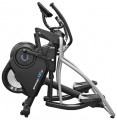Max. user weight
The maximum weight of the user for which the cross trainer is designed. This parameter should be adhered to as accurately as possible, do not be mistaken about the fact that 3-5 kg over the calculated weight will not affect the device. Yes, most likely, the simulator will be able to work for some time, but it will experience loads exceeding the calculated ones, and at best it will fail earlier than expected, and at worst it may break at the most unfortunate moment, which is fraught with injuries. In addition, this case is usually not covered by the manufacturer's warranty, and you will have to eliminate the consequences at your own expense.
Flywheel location
The location of the flywheel relative to the pedals of the cross trainer. Most often it is installed at the
rear, but there are also
models with front location. The differences between both options are very small, so in fact, only the appearance of the cross trainer depends on the location of the flywheel.
Step length
The maximum horizontal distance between the pedals of the cross trainer, determines, respectively, the length of the athlete's step when working on the machine. It is believed that for people of average height, a step length of 400 – 500 mm is optimal, and many cross trainers are made with this calculation. At the same time, there are models with a variable step length, which allows you to adjust it to the personal preferences of different users.
Anyway, the step length should be chosen depending on height, physique and personal preferences. Too small a step will lead to the fact that you have to mince, and the imitation of walking will turn into marking time, and too wide will lead to inconvenience and an unjustified increase in load without increasing efficiency. Ideally, it is advisable to test the cross trainer before buying — how comfortable you will be on it. This applies to both fixed and adjustable step lengths.
Step length adjustment
The ability to change the step length provided by the cross trainer(see above). This function allows you to customize the machine for athletes with different heights and physiques, for which the optimal step length will also be different; this is especially convenient if the cross trainers are in public use — for example, installed in a gym. However, such adjustment is expensive, and the real need for it is mainly for professional training. Therefore, most cross trainers with adjustable step lengths are top models.
Pedal adjustment
The ability
to change the angle of inclination of the pedals on which the feet are placed while working out on the cross trainer. Thus, you can change the direction of the load and focus on a particular muscle group. This feature is relatively rare, mainly in professional-level machines.
Dimensions
The dimensions of the equipment in the assembled and ready-to-work state. It is important to note that more space is needed for the comfortable and proper operation of the machine.

